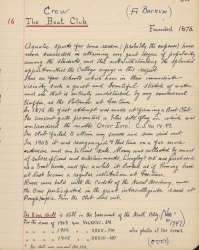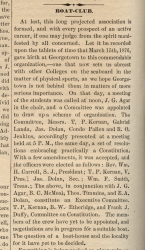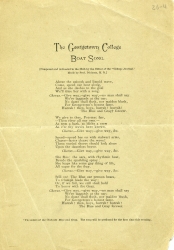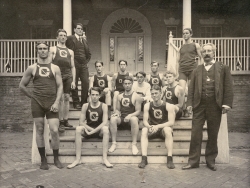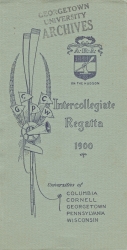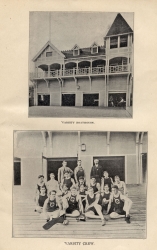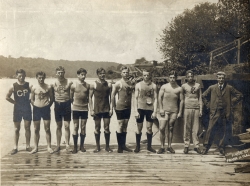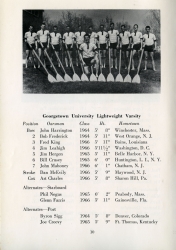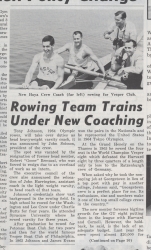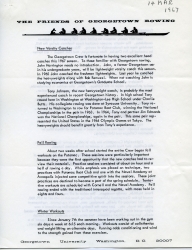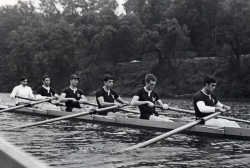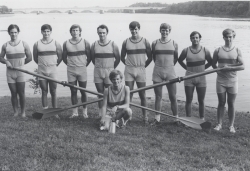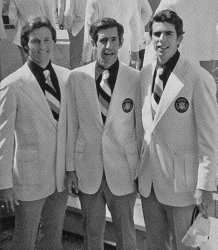Notes on the history of crew at Georgetown written by Georgetown University Archivist Francis Barnum, S.J.
Barnum, Francis, 1849-1921
some time after 1905, with additions in a later hand
Aquatic sports for some reason (probably the expense) have never succeeded in attaining any great degree of popularity among the students, and this notwithstanding the splendid opportunities the College enjoys in this respect . . .
Boat-Club : announcement of the formation of the Boat Club
Georgetown College Journal
April 1876
At last, this long projected association is formed, and with every prospect of an active career, if one may judge from the spirit manifested by all concerned. Let it be recorded upon the tablets of time that March 15th, 1876, gave birth at Georgetown to this commendable organization . . .
Selected readings in aid of the College Boat Club Fund : program and ticket
May 23, 1876
An early example of fund raising for crew. Among the performers, John Agar, who declaimed The Maniac of the Abbey by Robert Southey and The Widow Gray, and Clement Manley, who delivered The Vagabonds by Trowbridge. Both Agar and Manley were members of the committee which selected Blue and Gray as the Boat Club Colors.
Boat Club : report on selection of Blue and Gray as club colors and selection of the first six members for the crew
Georgetown College Journal
June 1876
One of the first actions of the Georgetown College Boat Club was to appoint a Committee on Colors. Georgetown did not have colors in 1876 and it was felt that they were needed so supporters on shore could identify the team during races. The College Journal article, the only account of the Committee’s work that has survived, explains how the Committee, looking for colors to express “the feeling of unity that exists between the Northern and Southern boys of the College,” recommended the adoption of Blue and Gray. A subsequent College Journal describes how the young ladies from the neighboring Visitation Academy immediately sewed a half blue, half gray banner, bearing the inscription Ocior Euro (“Swifter than the Wind” in Latin), and presented it to the College. The banner, now lost, was prominently displayed at commencements and other school events and its colors quickly became part of our tradition. The first six crew members were: Eugene McCarthy; William Francis Dammann, Jr.; James P. Dolan; Thomas F. Mallan; Martin J. Condon [later, mayor of his hometown of Knoxville, Tennessee]; and James Lynch. Mr. Randall, a member of the Potomac Boat Club, volunteered his services as Georgetown’s first coach.
Georgetown College boat song
Agar, John, (editor of the College Journal)
1876
Above the smooth and limpid wave, Come, speed our boat along, And as she dashes to the goal We’ll time her with a song. . .
John Agar
1874
John Agar (A.B. 1876, M.A. 1888, Ph.D. 1889, and LL.D. 1910) became editor of the Georgetown College Journal in 1875. Because he both held this position and played a leading role in the organization of the Boat Club, the details of the Club’s founding and formative years are well documented in the pages of the Journal. Agar’s contributions to Georgetown continued long after he ceased to be a student. Active in the Alumni Association, he urged, at the turn of the 20th century, the inclusion of lay alumni on the University’s Board of Directors – an idea finally implemented in 1967. He also conceived the idea for a Board of Regents, drafted its bylaws and, in 1914, became an inaugural member of that body.
Letter soliciting money for a boat house which has "just been completed and is now in the possession of the club"
Feb. 22, 1877
Sports on campus at this time had to be self-supporting. When the boat club approached President Patrick Healy in the spring of 1877 for a loan of $100 to buy a boat, he turned them down. The boat house alone cost $1100. Designed by J. L. Smithmeyer, whose firm designed Healy Hall, it stood on the Potomac just west of the College. In February 1881, a flood washed away the Boat Club’s shells and virtually destroyed the boat house, significantly stalling the momentum of the Club.
After aquatic honors : organizing the new crew at Georgetown University
The Washington Post
Mar. 9, 1890
Crew continued sporadically through the 1890s but “no systematic effort has been made to organize a regular crew and boat club.” In 1890, as this article reports, the Potomac Club offered the University a “four-oared gig for practice and a boat for a race.”
Sketch of Claude Zappone, Georgetown Crew Coach
Unknown Newspaper
1900
Claude E. Zappone (1858-1919) attended Georgetown in the 1870s. Prominently identified with the promotion of amateur rowing in the U.S., he was a member of the National Association of Amateur Oarsmen for 33 years, serving one term as that body’s president and acting as its treasurer from 1910 until his death. President of the Potomac Boat Club, he was coach of the Georgetown crew in 1900 and 1901, a time of resurgence for rowing on campus. His obituary in The Washington Post on March 24, 1919, termed him the father of rowing at Georgetown.
Roster for the 1900 Crew, printed in the 1901 Yearbook
1901
Among those named, J.[ames] P. B. Duffy, the first member of crew inducted into the Georgetown Athletic Hall of Fame.
James P. B. Duffy (A.B. 1901, LL.D 1951), pictured in the 1901 Yearbook
1901
On June 10, 1961, James Duffy became the first member of crew to be added to the Georgetown Athletic Hall of Fame. He was recognized for his work as a member of the 1900 and 1901 varsity crew, rowing No. 5 starboard in 1900 and No. 7 starboard in 1901. The induction took place at the 60th reunion of his Georgetown class. Duffy was elected from New York as a Democrat to Congress in 1935 and in 1937 was appointed as Justice of the Supreme Court of the State of New York in the 7th Judicial District. In 1951, Georgetown awarded him an honorary Doctor of Laws.
Georgetown outrows Annapolis Eight
Georgetown crew victory from an unknown newspaper
May 18, 1900
Yesterday was the greatest day yet in Georgetown University’s aquatic history. It marked the first victory since the “blue and gray” went into rowing, and the achievement is all the more notable because her crew won a two mile race from so formidable a rival as the Naval Academy’s big “eight.” Although the Boat Club had been formed in 1876, it was not until 1900 that Georgetown entered intercollegiate races.
Program from annual regatta of the Intercollegiate Association
1900
Poughkeepsie was the venue of this, the nation’s prime intercollegiate regatta. Teams from Columbia, Cornell, Georgetown, Pennsylvania and Wisconsin entered the June 30, 1900 competition. The Washington Post noted in its coverage of the event that: Considering that Mr. Zappone had only twenty candidates from which to select his eight, he has certainly assembled a very likely looking crew. The men are all fine specimens of physical development, having an average age of twenty years, an average height of six feet and five-eights of an inch, and average weight of 165 3/4 pounds. Official 1900 finish times for the four-mile course: Pennsylvania: 19.44 3-5 Wisconsin: 19:46 2-5 Cornell: 20.04 1-5 Columbia: 20.08 1-5 Georgetown: 20.19 1-5
Varsity boathouse and varsity crew, pictured in the Georgetown College Journal
Georgetown College Journal
July 1901
The boathouse, located at the foot of 32nd Street on government property, was purchased from the Columbia Athletic Club in the spring of 1901. According to the College Journal, it consisted of three rooms – the boat room, ball room and locker room. The boat room had ample space for the six eight-oared, five four-oared, one centipede, four out-riggers, two four-oared, and two gunwale boats, together with a fifty-foot ten oared barge. Georgetown used this boathouse until July 1904 when it was razed.
Varsity crew on the Hudson
July 1901
The crew returned to Poughkeepsie and the Annual Regatta of the Intercollegiate Association in July 1901 but with very different results from the previous year. Georgetown did not win the four-mile race but, despite inexperience and very limited preparation, still managed to finish fourth and, with a time of 19 minutes and 21 seconds, better the existing intercollegiate record for the distance. The following expression of admiration appeared in the Georgetown College Journal, July 1901: No eight in the regatta deserves higher praise than the Georgetown Crew. They went into the race with but one previous contest as experience; half of them had never handled a sweep in a race before, yet Georgetown surprised everyone by holding on to the leaders in grand style. Such a combination of pluck and skill was entirely unlooked for; it was something even for seasoned oarsmen to have finished fourth in such a race and to have broken an intercollegiate record, but to have done all this with such little preparation and experience is, indeed, a thing to be remembered in the history of athletics at Georgetown.
Souvenir program from the Potomac River Regatta
Oct. 6, 1902
Five thousand people gathered along the waterfront to watch this event. Georgetown was represented by an eight and a four in the junior events.
Georgetown Crew at Poughkeepsie
1903
Georgetown made the Poughkeepsie regatta an annual event. In 1903 they finished second, their best finish there.
Georgetown crew coach Patrick A. Dempsey, sketch from The Washington Post
The Washington Post
Sept. 11, 1904
Born in Ireland, Patrick Dempsey was, at one time, rated as one of the nation’s leading scullers. He became Georgetown’s crew coach in 1902. He left in 1906 but returned in fall of 1909. He established, and for many years operated, Dempsey’s boathouse at 3600 K Street. That structure was leveled by fire in 1961.
Obituaries for Patrick Dempsey
Feb. 19, 1932
Prep crew
1905
The Georgetown College Preparatory School was housed on campus until 1919, when it moved to its Garrett Park, Montgomery County campus. Legal ties to Georgetown University were severed in 1927. Included in this group is, fourth from left, is Denis Dowd of Sea Cliff, Long Island, who graduated from the College in 1908. He was the first American to travel to Europe to enlist after the outbreak of World War I, sailing for France six days after the War began. He was killed when the plane he was flying crashed near Paris on August 11, 1916.
Menu from Morgan House Restaurant, Poughkeepsie, N.Y.
Jun. 28, 1905
This was a souvenir of the crew’s trip to 1905 Annual Regatta of the Intercollegiate Association.
First annual Georgetown Prom. Benefit of the crew at the New Willard
Lorando, Stephen T.
Apr. 14, 1904
This prom was attended by more than 300 people; music was provided by a section of the Marine Band. The crew, at this time, was facing huge financial issues. It did not have enough money to buy land for a boathouse and lack of funding began to impact its competition schedule. In fact, the crew did not compete in Poughkeepsie in 1908 or 1909, mainly because of a lack of funding. Correspondingly, interest in crew at Georgetown began to ebb.
Crew, account of the abolition of crew
Georgetown College Journal
February 1911
"The decision of the executive committee [of the University’s Athletic Association] several weeks ago to abolish crew for the present scholastic year came as a surprise to many of the students and the alumni . . . " The decision was made at a meeting on January 28, 1911 because crew was seen as a heavy drain on the University’s athletic funds. However, it was not intended to be permanent and the expectation was that the sport would resume the following year. However, it was five decades before the sport was again officially recognized at Georgetown.
By the river
ca. 1913
Georgetown students continued to row after the 1911 decision, without official University recognition and simply for fun. Like the first crew team in the 1876, they borrowed shells from the Potomac Boat Club.
Georgetown may have a crew on Potomac within a month
The Hoya
Feb. 5, 1920
Unsuccessful attempts to revive crew were made sporadically in the 1920s and 1930s.
For old times’ sake, advertisement in The Washington Post for Heurich’s Maerzen Beer
The Washington Post
Aug. 6, 1934
By the 1930s, the idea of crew at Georgetown was a distant memory, used to create a sense of nostalgia for a local brewery’s ad campaign. The Heurich Brewing Company, which closed in 1956, had a massive plant on the site of what is today the Kennedy Center.
Sweep swingers
Ye Domesday Booke
1941
During the 1940-1941 academic year, a group of some 40 Georgetown students formed a rowing club. Using shells borrowed from the Potomac Boat Club, they competed in five races, wining one (on the Potomac against Rollins College.)
Georgetown crew roster
1957-1958; 1958-1959
In the spring of 1958, George Washington Crew Coach, Fred Maletz, posted a notice on a restaurant window in Georgetown, calling for recruits to help the GW crew practice. After 45 Hoya undergraduates responded, Maletz found himself coaching two crews and was unpaid for his work with the Georgetown crew. The informal Georgetown team used one shell borrowed from GW and another borrowed from the Potomac Boat Club.
Program from dedication of the National Capital Water Sports Center
Sept. 24, 1960
In 1960, the Water Sports Center, now known as the Thompson Boat Center, was dedicated, ensuring that the Georgetown crew had place to store its boats.
Ye Domesday Booke
1960
A year before regaining University recognition, coverage of the crew team returned to pages of the yearbook.
Varsity crew returns to Georgetown after fifty years
Georgetown University Alumni Magazine
March 1961
In 1961, Crew was given University recognition and an annual budget of $1000.
Senior gift to provide crew with shell, oars
The Hoya
Jan. 19, 1961
In total, the Class of 1961 raised $3100.
Crew budget
1961
Total income was $11, 379, mostly from gifts and donations. Total expenses were $9, 225.
Don D. Cadle, crew coach, pictured in Ye Domesday Booke
Ye Domesday Booke
1964
In March 1960, Fred Maletz, who worked for the State Department, was transferred to the American Embassy in Iran and Don Cadle, a former Yale and Oxford crew member, volunteered as head Crew Coach. During the season, he ran a morning workout at 6:00 a.m., put in a full day at NASA, and returned for the end of the freshman workout at 6 p.m. The 1964 Yearbook paid tribute to his dedication and coaching ability: The unique English system of organization and the theory of crew are by far the greatest contributions of the former Yale-Oxford oarsman. This philosophy, so applicable to life in general, is inherent in every success story–hard work, dedication, and magnanimity. These ideals he taught through example; the realization and reward felt in a flawless “eight” when all are mentally and physically together, a feeling of perfection, achievement, and comradeship– the feeling of actual power that men can produce when they work together for a common goal. All of this is had through voluntary individual commitment, and is bound in an unshakeable fraternal relationship.
Georgetown oarsmen bid farewell to coach Cadle
The Washington Post
Mar. 16, 1964
Coach Cadle moved to Germany in 1964 to enter his family’s textile business. However, he stayed in touch with Georgetown and its rowers, writing to them, phoning after races to learn the results, and even sending uniforms.
Record of 1961 Georgetown University crews
The Washington Post
1961
The crew compiled a creditable record, highlighted by a second place finish in small college national rowing championship at the Dad Vail Regatta in Philadelphia.
Program for Georgetown University Athletic Award Banquet
May 15, 1961
Signed by 11 of the 13 crew members who were awarded “G” certificates.
Crew team
Ye Domesday Booke
1962
In 1962, the crew went undefeated and won the varsity and junior varsity titles at the Dad Vail Regatta.
Dad Vail Regatta program
1962
Georgetown Crews dominate Vail Races
Philadelphia Inquirer
May 13, 1962
The Georgetown varsity eight defeated 21 college boats to win by more than three boat lengths. In a near sweep, Georgetown also won the junior varsity race and was runner-up for the freshman title.
Georgetown Eight wins in Dad Vail Regatta
Philadelphia Bulletin
May 13, 1962
The Georgetown varsity eight defeated 21 college boats to win by more than three boat lengths. In a near sweep, Georgetown also won the junior varsity race and was runner-up for the freshman title.
Flyer for Ratzeburg vs. Georgetown race
Apr. 20, 1963
The eight from the Ratzeburg Rowing Club in Germany had won the 1962 world championship at 2,000 meters with a time of five minutes 50.8 seconds. The Germans defeated Georgetown by three lengths in a time of 6 minutes 3 seconds. Georgetown finished in 6 minutes 15 and St. Joseph’s College of Philadelphia in 6 minutes 22.5 seconds. In the 1963 season, the varsity crew defeated all its regular season opponents, losing only to Ratzeburg and placing second at the Vails.
Program from benefit concert for crew
May 3, 1963
As in the early days of the century, student organizations put on benefit concerts to raise money for crew. Note the make-up of the “challenge team” on the back cover of the program. The first four team members from bottom to top are: John F. Kennedy, U.S. President; Edward B. Bunn, S.J., Georgetown President; Don Cadle, Head Coach of the Georgetown Crew, who had rowed for Oxford and Yale; and Richard M. Nixon, who had narrowly lost the 1960 Presidential election to Kennedy.
Commander V.G. “Sandy” Sanborn, Georgetown crew coach
1964
Coach Sanborn, an investigator for the Federal Aviation Agency, offered to leave his paying position as head coach at George Washington University to replace Don Cadle as Georgetown Coach in January 1964. He left the Hoyas that June because of a job relocation but not before he coached them to a Dad Vail victory.
Crew
Ye Domesday Booke
1964
In 1964, the Varsity Crew again won at the Vail. This victory was not a foregone conclusion, however. The Hoyas had lost the D.C. Area Championships the previous week. And earlier in the season, they had been defeated by the traditionally strong teams of Marietta and St. Joseph’s, both of whom lost to the Hoyas at the Vail.
1964 crew celebrates 25 years of gold
Georgetown Rowing Association Alumni Newsletter
Fall 1989
On May 13, 1989, the Georgetown heavyweight varsity crew of 1964 again took to the Schuylkill, not for a race but for a commemorative row-by. In the shell were: Rick Reynolds, ‘65 (for the missing Fred Vollbrecht), Mark Pisano, ‘64, Bill MacNeill, ‘66, Darro Angelini, ‘66, Jack Hoeschler, ‘64, Pete Blyberg, ‘65, Marc O’Brien, ‘64 (for the deceased Mike Mullen), Linc Hoffman, ‘65 (for Dan Ebert, killed in Vietnam), and coxswain Doug (Tiger) Sergeant, ‘64.
The new Georgetown lightweight crew
Crew Boosters Yearbook
1964
In a lightweight boat, the maximum weight for an oarsman is 155 pounds, and the boat cannot average over 150 pounds per man. The Lightweights actually formed during the 1963 season but did not compete until 1964.
Oars on display in the Tombs
Georgetown's Blue and Grey
Marchese, John (photographer)
1987
According to an essay, “The History of the Georgetown Crew” by Lawrence H. Cooke which appears in the book, Swift Potomac’s Lovely Daughter: Two Centuries at Georgetown through Student’s Eyes, the 1964 Vail winning season marked the beginning of the long association between the crew and the Tombs restaurant. Many of the 1965 rowers called themselves the Black Velvets because several oarsmen would go to the Tombs to drink a combination of Guinness beer and champagne. The Tombs was opened by Richard McCooey (C’52) in 1962. Today numerous oars commemorating Georgetown crew successes are displayed on the restaurant’s wall.
Statement of finances, Georgetown University Rowing Association
Georgetown University Rowing Association
Fiscal Year 1965-1966
All coaching was on a volunteer basis. The crew’s alumni association, the Golden Oar Society, contributed $1100 during this academic year.
5 veteran oarsmen dedicated to coaching crew
The Hoya
Mar. 11, 1965
After the departure of Coach Sanborn, a group of Georgetown alumni, including Frank Barrett and Robert Remuzzi (who coached while attending Medical School), took on coaching duties.
Georgetown University Rowing Association capital assets : a financial evaluation of the Georgetown University Rowing Association
Georgetown University Rowing Association
Feb. 15, 1966
Despite relatively small allotments of money from the University (for the 1965-1966 academic year, the sum was $2000), the Crew managed to amass about $27,500 worth of capital equipment, a testament to their determination and the generosity of their supporters.
"Rowing Team Trains Under New Coach." The Hoya, September 29, 1966
The Hoya
Sept. 29, 1966
In the fall of 1966, Tony Johnson became Head Heavyweight Crew Coach. A native of Arlington, Virginia, Johnson rowed for Syracuse during his college career. The Georgetown job was his first coaching position. He had an immediate impact on the crew program–in 1967 the varsity eight came second at the Dad Vail Regatta and won in 1968 and 1969. In the summer of 1969 he was recruited by Yale to become their head coach. While at Yale, his squads won several major championships, including the national title in 1982. He was named Eastern Coach of the Year the same year. He would return to Georgetown in the fall of 1989.
Tony Johnson and his partner Larry Hough, pictured in the Hoya
The Hoya
Oct. 10, 1968
One of the nation’s leading oarsmen, Johnson coached while training for the 1968 Olympics in Mexico. He had represented the U.S. with Jim Edmunds in the Tokyo Olympics in 1964 and finished tenth. In 1967, he and partner Larry Hough, an ensign in the Navy, became U.S., Pan American, and European Champions. They were favored to win gold at Mexico City but rowed to a silver. In one of a series of accounts written for The Hoya by Johnson while in Mexico City, he was phlegmatic about his silver medal saying: Larry and I rowed a good race and we have no complaints or excuses. Johnson was Georgetown’s first Olympic competitor in a non‑track and field event. He returned to the Olympics in 1972 as the assistant U.S. rowing coach.
Letter from Charles J. Duffey announcing the formation of the Friends of Georgetown Rowing
Duffey, Charles J.
Mar. 14, 1967
First issue of the Friends of Georgetown Rowing newsletter
The Friends of Georgetown Rowing
March 1967
Georgetown captures Potomac rowing crown
The Washington Post
May 5, 1968
The Georgetown heavyweight eight won the Washington area championship in a time of 5:58 for 2000 meters.
Dad Vail Regatta : Georgetown varsity heavyweight crew celebrate their full-length victory over defending champions Marietta
Sanders, Steve (photographer)
1968
At the 1968 Dad Vail Regatta, the Hoyas captured the Jack Bratten Trophy for overall points. The Heavyweight Eight, Rusty Duffy, John Napolitano, Steve Bavaria, Jack Murray, Fred Pennekamp, Mike Vespoli, Ron DeGrandis, stroke Rick Morris, and coxswain John King rowed to victory in a time of 6:00.6, a course record. The junior varsity heavyweight crew and freshman heavyweight team finished third and second respectively.
Michael L. Vespoli (B’68), pictured in Georgetown Today
Georgetown Today
July 1975
When Michael Vespoli tried out for the Georgetown freshman crew team, he had never stroked an oar. During his senior year, however, his boat won the Dad Vail gold and, by 1972, he was an Olympian, placing fifth in the coxed four in the Munich final. He continued to compete for four years after Munich, rowing in the eight that won gold in the 1974 World Championships and 1975 Pan American Games, finishing fifth in the 1975 Worlds, and qualifying for the 1976 Olympic trials. After holding a number of coaching positions, he decided to go into the boat-building business. The company he founded, Vespoli USA, became the largest manufacturer of rowing shells in North America and the largest producer of 8-oar shells worldwide. In 1979, he became one of the youngest inductees into GU’s Athletic hall of Fame and, in 1984, he was inducted into the National Rowing Foundation Hall of Fame.
The guru of crew, profile of Michael Vespoli
Georgetown Magazine
Spring/Summer 1999
Varsity crew
1969
1969 saw a repeat as the overall point champions at Dad Vail. The Hoya heavyweights won the Dad Vail Cup, while the junior varsity heavyweights took third and freshman heavyweights finished second.
Memorial tribute to Greg Carroll, C’71
Georgetown Magazine
Winter 1990
Greg Carroll played many roles in the development of rowing at Georgetown, including those of oarsman (1968-1971), coach, and fund-raiser. In 1989, the crew dedicated two new four-oared shells, one to the memory of Dick Follett, father of Kendra Follett, C’86, and one – Mr. Wonderful – to the memory of Greg Carroll.
Benson to coach Georgetown crew
Georgetown University News Service Release
Sept. 30, 1969
Profile on Frederick H. Pennekamp, F'70
Hoya Saxa
April 1988
Pennekamp was inducted into the Georgetown Athletic Hall of Fame in 1984 and, in 1999, he received the John Carroll Award.
John J. “Jay” Forster (B’70), pictured left with Tony Johnson and Michael Vespoli at the 1972 Olympics
Georgetown Magazine
Spring/Summer 1999
Forster learned to row as an undergraduate at Georgetown and continued after graduation from the Business School in 1970. He rowed (with Michael Vespoli) in the U.S. four-oared-shell-with-coxswain team in the Munich Olympics in 1972 and was a member of the U.S. National teams that competed in the World Championships in 1973, 1974, 1975 and 1977. He won a gold medal at the 1975 Pan American Games in the four-without-coxswain event.
Crew John J. Forster, 9th Year, special coaches issue of Hoya Saxa
Hoya Saxa
August 1985
A Marine Corps veteran who was awarded two Purple Heart Medals in Vietnam, Forster served in various capacities in Georgetown’s Athletic Department, including as assistant athletic director for finance, as head coach of men’s crew, and as overall coordinator of the men’s and women’s crews. In 1982, he was inducted into the Georgetown University Athletic Hall of Fame.
Crew rosters
1970-1971
Race report from Dad Vail Regatta
May 8, 1971
The varsity heavyweights won the gold medal for the fifth time in ten years, beating St. Joseph’s in rain and fog by 5.5 seconds.
Profile of Erik J. Meyers, F’71, from Georgetown Athletic Hall of Fame induction ceremony
Jan. 30, 1982
Meyers rowed on four medal-winning boats (two golds and two silvers) in the Dad Vail regattas during his years at Georgetown. After graduation, he won gold medals in two U.S. Nationals championships. At the induction ceremony he commented that "I feel my former teammates are responsible for much if not most of my athletic success, and I am deeply touched and honored that they think I should be up here tonight."
Female Coxswain draws ECAC eye
The Washington Post
Apr. 30, 1972
In 1972, Delanne Bernier served as coxswain for the crew and drew the ire of the Eastern Collegiate Athletic Conference whose rules forbade women to compete with men in ECAC events. Fifteen years earlier, the ECAC had enforced the same rule, barring Kathleen D. “Skippy” White, N’57 and Carole Bloise, N’58 (the first two Georgetown woman to win varsity letters) from competing in sailing events.
Crew, photographs from Ye Domesday Booke
1972
GURA : officers and coaches for the year 1974-1975
1974-1975
Women’s sports club forms first crew team this season
The Hoya
Sept. 19, 1975
As a club, the women’s crew received no money from the University, organizing social events, row-a-thons and bake sales to fund their activities. In 1978, the Athletic Board voted to recommend the elevation of Women’s Crew to varsity status.
Ye Domesday Booke
1975
John P. Devlin, C’71 : head coach of women’s crew, 1977-1990
Under Coach Devlin’s guidance, the Hoyas won five gold medals at the Dad Vail Championships. Georgetown also earned seven trips to the U.S. Collegiate Championships, bringing home the gold medal – Georgetown’s first – in 1988. Georgetown named him Coach of the Year in 1987. A four-year heavyweight oarsman at Georgetown himself, Devlin was heavyweight captain his senior year and was a member of the 1969 and 1971 Dad Vail gold medal teams. After college, he competed with the New Haven Rowing Club and the Potomac Boat Club, wining two gold medals in the Canadian Henley and a silver at the U.S. Nationals. Devlin was also a finalist in the 1972 Olympic Trials and the 1974 and 1975 World Championship trials. In 2002, he was inducted into the Georgetown Athletic Hall of Fame.
Thank you card for crew supporters, with cover illustration by Joseph Wesner, C’77
Wesner, Joseph
The inside of the card reads: Rowing dialogue by Joseph Wesner, C’77 Rowing to both participant and supporter is a chaotic and powerful collection of elements. This drawing depicts the symmetry, motion, strength, and awkward finesse that powers an eight-oared shell down a course. The artist is a varsity heavyweight oarsman at Georgetown.
Crew
Ye Domesday Booke
1978
From the Potomac to the Thames
Georgetown Magazine
July-August 1979
Four members of the Georgetown Varsity Crew Team competed at the Henley Royal Regatta, the oldest regatta, on the Thames River in England. Jim Costello, Dave McAneny, Peter Radell and Mark Wessel placed in the top four of 27 teams. This was the first time a Hoya crew had competed in international competition.
Crew rosters
1979-1980
Profile of Jo Ann Grainger, C’80, from Georgetown Hall of Fame induction program
1996
Jo Ann Grainger was the first member of the women’s crew to be inducted into the Georgetown Athletic Hall of Fame. Over the course of the 1978, 1979 and 1980 seasons, the women’s varsity crew of which she was a part lost only one regular season race and won a silver medal at the Dad Vail Regatta in 1980. After graduation, she and Lynne Kosobucki, C’83, won the U.S. National Lightweight Pair title. In 1984, she won a gold medal at the World Championships.
Oarsmen face Egyptian Nat’l Federation
Mar. 27, 1981
Georgetown began its season by defeating the Egyptian Rowing Federation and the Potomac Boat Club in eights on the Potomac. The Egyptians won a fours race by 3 seconds over PBC and 6.5 seconds over Georgetown. During their stay in Washington, the Egyptian rowers were housed by members of GURA.
Crew
Ye Domesday Booke
1982
G.W.R.A. information
Fall 1982
GU women win Dad Vail title
The Washington Post
May 15, 1983
The women’s varsity and junior varsity crews were gold medal winners at the small college national rowing championship at Dad Vail in Philadelphia in 1983. The women’s varsity crew also won there in 1987 and 1993. For the first time in over a decade, the Hoya took home the Jack Bratten Trophy for overall points, with the freshman heavyweights placing third and the freshmen and JV lightweight eights both capturing silver medals.
Frederick V. Schoch, head coach of the crew program
1986-1989
Coach Schoch was the first full-time coach in Georgetown rowing history. He oversaw the transition of crew from a student-run organization to a team fully integrated into the Athletic Department. Georgetown crews won nine Dad Vail medals in the years he served as head coach and won the Jack Bratten Trophy for overall points twice.
Schoch selected to head Georgetown crew program
Aug. 14, 1986
Athletic news from Georgetown University.
Crew
1986-1987
This year brought another good showing at the Vail for the women, as the women’s junior varsity eight won a silver and the team captured the Evelyn Bergman Cup in the finals of the women’s varsity eight. The men’s freshman lightweight eight won their division.
Crew
1987-1988
Kelley Jones, C'88, pictured in Hoya Saxa
Hoya Saxa
May 1988
After playing field hockey as a freshman, Kelley Jones began rowing in her sophomore year. As a junior she and her teammates won a gold medal at the 1987 Dad Vail Regatta in the open-8 event. As a senior she was named team MVP and helped power her open-4 crew to a gold medal at the NCAA Women’s Rowing Championships. She also represented the U.S., rowing for the national team from 1989-1992, capping her international career by participating in the 1992 Olympic games.
Georgetown men’s varsity lightweight eight win at Dad Vail, 1988, picture from Dad Vail Regatta Program
1989
The 1988 season saw the Georgetown men’s lightweight eight win the first of three consecutive small college national rowing championships at the Dad Vail Regatta. The Hoyas captured the Jack Bratten Trophy for overall points with a win for the men’s junior varsity lightweight eight and a second place finish for the men’s novice/freshman lightweight eight.
Crew : Georgetown defends title with narrow Dad Vail victory
The Washington Post
May 14, 1989
For the second consecutive year, Georgetown’s varsity and junior varsity lightweights both won gold medals. The novice/freshman lightweights also won gold, completing a Georgetown sweep of the lightweight events. Based on the team’s repeated success at the Dad Vail Regatta, the Varsity Lightweight team was invited to compete for the 1989 National Collegiate Lightweight Championship, finishing fifth.
Tony Johnson comes home to Georgetown
Georgetown Rowing Alumni Association Newsletter
Fall 1989
After an absence of twenty years, Tony Johnson, an Arlington, Virginia native, returned to the Hilltop as head coach. Robert Remuzzi, C’61, M’66, who – with Frank Barrett – preceded Tony Johnson as head-coach in the mid-1960s, said of Johnson’s return: "Tony and the program do very well with each other . . . he was a tremendous asset when he was at Georgetown and we were very sorry when he left . . ."
Hoyas repeat in Dad Vail
Georgetown Rowing Association Newsletter
Summer 1990
Hoya crew captures first ever IRA championship title
1991
Pictured, second from left, Coach Tony Johnson with Marc Siegel, Neal Gardner, Goff Baker, Brad Moriarty, and coxswain Julie Kennedy The Hoya men’s crew won its first Intercollegiate Rowing Association Championship with a victory in the varsity four with coxswain at the 89th IRA Championships on Lake Onondaga in Syracuse, N.Y. They won the race in a time of 7:12.6, beating Navy by 1.2 seconds.
A Tradition of Excellence ...
Ye Domesday Booke
1991
Wine labels, produced to commemorate the inauguration of Bill Clinton (F’68) as U.S. President, depicting the crew on the Potomac
The labels were produced for bottles of wine, provided by Robert M. Wagner (F’48), from Maddalena Vineyards, Los Angeles, California.
Program and results : 1993 Dad Vail Regatta
1993
In 1993 the Hoya crew team captured its third consecutive Jack Bratten Trophy for overall points and won medals in six events at the small college national rowing championship at Dad Vail in Philadelphia. The women’s heavyweight eight won, repeating their gold medal performances from 1983 and 1987, and the men’s lightweight JV won its sixth Dad Vail medal in a row.
Georgetown crew returns from successful trip to Japan
Georgetown Rowing Alumni Association Newsletter
Summer 1994
. . . What we will take from this trip is not the rowing, the practices, but the cultural experiences and the friendships that we made with the Japanese people, as well as a tighter bond forged within our team.
Draft itinerary of Japan trip
May 5, 1994
Women’s varsity crew and men’s heavyweight crew
1996-1997
Crew
1998-1999
Conal Groom and Missy Schwen Ryan, picture from the Blue & Gray
Blue & Gray
Aug. 28-Sept. 10, 2000
Conal Groom (C’95) competed in the lightweight men’s double at the 2000 Summer Olympics in Sydney. Missy Schwen Ryan (F’94), who won a silver medal at the 1996 Olympics, competed in the women’s coxless pair repechage at the Sydney Games, capturing bronze.
Crew
Ye Domesday Booke
2003
Crew : 2006-2007 season
Ye Domesday Booke
2007
Curated by Lynn Conway, University Archivist

